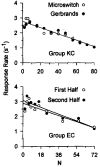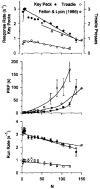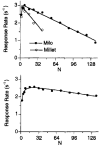Models of ratio schedule performance
- PMID: 9206029
- PMCID: PMC2593642
- DOI: 10.1037//0097-7403.23.3.351
Models of ratio schedule performance
Abstract
Predictions of P. R. Killeen's (1994) mathematical principles of reinforcement were tested for responding on ratio reinforcement schedules. The type of response key, the number of sessions per condition, and first vs. second half of a session had negligible effects on responding. Longer reinforcer durations and larger grain types engendered more responding, affecting primarily the parameter alpha (specific activation). Key pecking was faster than treadle pressing, affecting primarily the parameter delta (response time). Longer intertrial intervals led to higher overall response rates and shorter postreinforcement pauses and higher running rates, and ruled out some competing explanations. The treadle data required a distinction between the energetic requirements and rate-limiting properties of extended responses. The theory was extended to predict pause durations and run rates on ratio schedules.
Figures












References
-
- Beam JJ, Killeen PR, Bizo LA, Fetterman JG. Adjusting the pacemaker: The role of reinforcement context. 1997 Manuscript submitted for publication.

